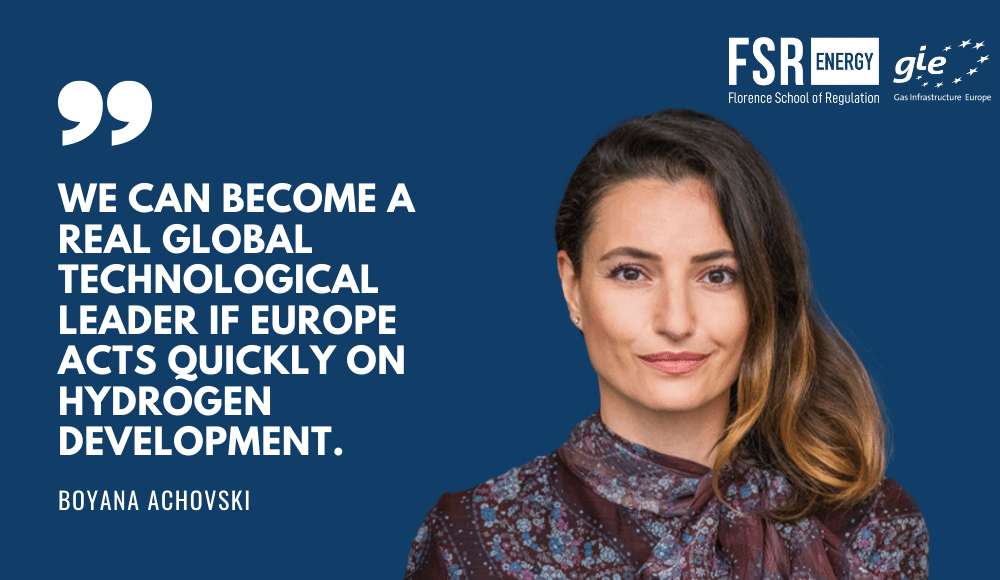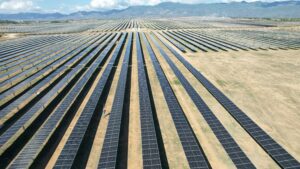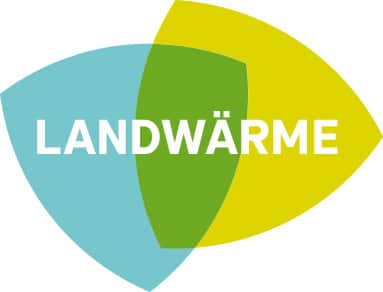Gas infrastructure: the road ahead

Lights on Women sits down with Boyana Achovski to discuss her vital role as Secretary General of Gas Infrastructure Europe.
In this interview, Ms. Achovski examines the future of gas storage, hydrogen capabilities and decarbonisation. Drawing from her experience, she concludes this interview by analysing different approaches on how to empower women in energy.
Q: Boyana, can you guide us through your journey into the energy sector?
It was an unplanned journey. After a unique career as a Bulgarian in the European Parliament (as we were just entering the EU), I returned to my country to focus more on my personal life. Following a short “mama” break, it was time to return to action. I have a background in economics and never really thought about getting involved in energy. The opportunity came and, from one day to another, I was deeply ingrained in the gas infrastructure field with major responsibilities as I took over the international relations of the Bulgarian gas combined operator. My responsibilities included reporting to the EU institutions and financial bodies (EBRD) on the implementations of the main projects of the company – the interconnectors and some of the planned internal upgrades of the system. Within my international mission, I was responsible for our relations with the European partners, the Gas Infrastructure Europe (GIE) and the European Network of Transmission System Operators for Gas; a few years later I became the first employee of Bulgartransgaz that was seconded to GIE. Since then, my journey with GIE is quite known.
Q: Can you tell us more about your role in Gas Infrastructure Europe and what your key responsibilities are?
GIE is an association representing the sole interest of the infrastructure industry in the gas business with 70 members in 26 European countries. I was Deputy Secretary General of GIE for four years. In my current role as Secretary General, I am completing my fourth year as well. I am in charge of the management of the company, supporting the GIE Board and implementing their decisions. I am also one of the front runners on voicing our position on decarbonisation towards the external fora. My day-to-day responsibility that I enjoy a lot is the management of the GIE team, which I am truly proud of.
Q: What are the priorities the gas sector needs to promptly address? How will GIE play a role?
The priorities in the gas sector nowadays are mainly related to the ambition of the EU’s climate-neutrality objectives and the EU Green Deal. Our members have been fundamental in the process over the last decade for internal gas market completion, significantly contributing to the diversification of routes and sources, security of supply, flexibility and competition across the Union. We were active and very effective. Now, we are focusing on our commitment to contribute to the short, mid and long-term climate ambitions through the supply of natural gas and renewable and decarbonised gases through our well-developed system. Recognising the opportunities as well as the challenges, we are ready to innovate our business to contribute to the EU climate and energy targets. In addition, our infrastructure is expected to play an essential role in the decarbonisation of the CEE & SEE regions enabling the coal-to-gas switch and the deployment of renewable and low-carbon gases.
Q: Speaking of EU decarbonisation targets: what opportunities do you see?
EU decarbonisation targets present many exciting opportunities, which, of course, needs effort to be achieved. Targets for both 2030 and 2050 are important for the development of various technologies like Biomethane, Hydrogen, CCUS and Power-to-X.
Q: What lies ahead for gas infrastructure? What will be the role of gas storage?
The gas infrastructure is the backbone of energy throughout Europe: our LNG import terminals receive large quantities of energy that secure and diversify energy supply; our transmission pipelines deliver x gases throughout the EU28 and our underground storage facilities store the gas needed to balance both the gas and electric grids and to provide seasonal back up. In line with the Green Deal ambitions, our members are already underway with preparations to facilitate the increased delivery and storage of sustainable gases, including biomethane, synthetic methane and hydrogen – be these in liquid or gaseous form. All our facilities can be used for renewable and decarbonised gases. We can convert gas pipelines to carry Hydrogen and LNG terminals can be the entry gate for liquid Hydrogen for all around the world. As before, gas storage will be the best flexibility provider to balance the future system.
Q: A recent article highlighted that hydrogen could unlock North Africa’s generation potential, with geopolitical implications for Europe. Do you think this will soon become a reality? Could this be a role model for other emerging countries?
The sooner, the better. Hydrogen has emerged as the solution best suited to reduce CO2 emissions in sectors where electrification seems unfeasible or relatively inefficient. To achieve CO2 emission reduction, hydrogen appears to be the appropriate solution. Speaking on behalf of our business model, I would say that hydrogen can be transported over long distances and stored in large quantities, making use of well-developed gas infrastructure.
Hydrogen can optimize the energy system by making use of possible synergies between the gas and electricity infrastructure.
Based on a combination of gas assets including storage, transmission and LNG infrastructures, hydrogen can optimize the energy system by making use of possible synergies between the gas and electricity infrastructure. We can become a real global technological leader if Europe acts quickly on hydrogen development.
Q: Can you tell us more about the #WomeninGIE initiative? How did it originate?
Every year GIE organizes a huge event, our GIE Annual Conference, where we gather more than 380 people. Last year we had the chance to have FSR with us. As this event is running for more than 17 years, with each edition we would like to present something different from the ‘regular’ content topics and bring more air between debates. In Paris in 2018, we brought the topic “Women in Energy” and it was surprisingly well accepted, it brought forth interesting reactions mainly from male participants. As our social visibility is very dynamic this year, we decided to explore the topic further by focusing on our faces, mainly featuring women from our member companies, sharing new perspectives to the interesting activities they are working on.
Q: What further steps can we take to bring more women professionals and experts to contribute to the energy transition in Europe and beyond?
Good question. I recently completed a Master’s thesis where the topic of the final paper was Women In Energy and it focused on how to increase female participation in senior leadership. Long story short, it is important to emphasize the different actions for the retainment of female employees applied by energy companies that could provide women with tremendous potential to grow and progress quickly compared to their competitors that continue to maintain the old stereotypical approach to genders, as the sector is very much represented by males. Expanding the influence of networks of female professionals, with the main purpose of promoting the visibility of women, could be another effective approach. We could also be motivated by proper advertising of vacancy positions and particular benefits and allowances for applicants, including flexibility in working hours as well as working from home. For the moment, I also think that GIE is having a role to play in this perspective with the emphasis that we put on our female professionals and the wonderful team we have in Brussels.
About Boyana Achovski
Since September 2016, Boyana Achovski serves as Secretary General of Gas Infrastructure Europe (GIE), the European association of gas transmission, gas storage and LNG regasification terminal operators. Before joining GIE, Boyana Achovski worked for Bulgartransgaz, the Bulgarian transmission and storage operator, where she led the Analysis and International Operations Division. Mrs Achovski graduated in International Economic Affairs, specialized in International Finance and holds a Master’s degree in Finance.
Stay in the know
Get the Lights on Women newsletter.






